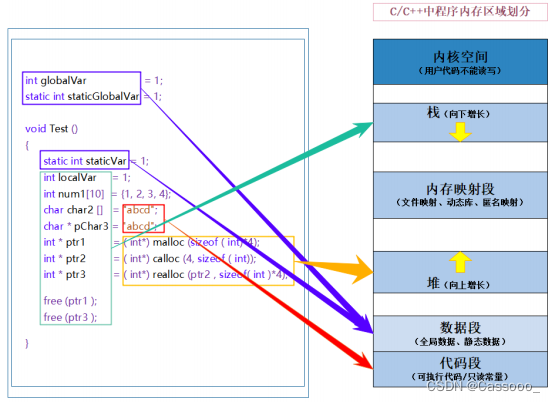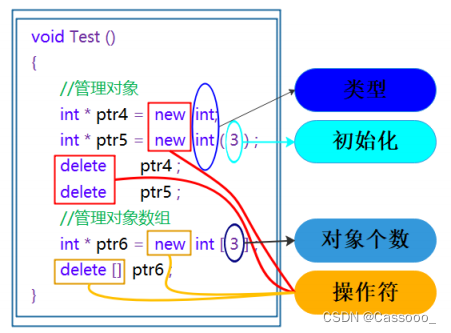您现在的位置是:首页 >技术交流 >【C++学习】C&C++内存管理网站首页技术交流
【C++学习】C&C++内存管理
简介【C++学习】C&C++内存管理
目录
二、C语言中动态内存管理方式:malloc/calloc/realloc/free
四、operator new与operator delete函数
4.1 operator new与operator delete函数(重点)
一、C&C++内存管理
我们先来看下面的一段代码和相关问题:
int globalVar = 1;
static int staticGlobalVar = 1;
void Test()
{
static int staticVar = 1;
int localVar = 1;
int num1[10] = { 1, 2, 3, 4 };
char char2[] = "abcd";
const char* pChar3 = "abcd";
int* ptr1 = (int*)malloc(sizeof(int) * 4);
int* ptr2 = (int*)calloc(4, sizeof(int));
int* ptr3 = (int*)realloc(ptr2, sizeof(int) * 4);
free(ptr1);
free(ptr3);
}
1.
选择题:
选项:
A
.
栈
B
.
堆
C
.
数据段
(
静态区)
D
.
代码段
(
常量区
)
globalVar
在哪里?
____
staticGlobalVar在哪里?
____
staticVar
在哪里?
____
localVar在哪里?
____
num1
在哪里?
____
char2
在哪里?
____
*
char2
在哪里?
___
pChar3
在哪里?
____
*
pChar3
在哪里?
____
ptr1
在哪里?
____
*
ptr1
在哪里?
____
2.
填空题:
sizeof
(
num1
)
=
____
sizeof
(
char2
)
=
____
strlen
(
char2
)
=
____
sizeof
(
pChar3
)
=
____
strlen
(
pChar3
)
=
____
sizeof
(
ptr1
)
=
____
3.
sizeof
和
strlen
区别?

【说明】
- 栈又叫堆栈——非静态局部变量/函数参数/返回值等等,栈是向下增长的。
- 内存映射段是高效的I/O映射方式,用于装载一个共享的动态内存库。用户可使用系统接口创建共享共享内存,做进程间通信。
- 堆用于程序运行时动态内存分配,堆是可以上增长的。
- 数据段——存储全局数据和静态数据。
- 代码段——可执行的代码/只读常量。
二、C语言中动态内存管理方式:malloc/calloc/realloc/free
void Test ()
{
int* p1 = (int*) malloc(sizeof(int));
free(p1);
// 1.malloc/calloc/realloc的区别是什么?
int* p2 = (int*)calloc(4, sizeof (int));
int* p3 = (int*)realloc(p2, sizeof(int)*10);
// 这里需要free(p2)吗?
free(p3 );
}malloc的实现原理:Glibc中malloc实现原理
三、C++内存管理方式
C语言内存管理方式在
C++
中可以继续使用,但有些地方就无能为力,而且使用起来比较麻烦,因此C++
又提出了自己的内存管理方式:
通过
new
和
delete
操作符进行动态内存管理。
3.1 new/delete操作内置类型
void Test()
{
// 动态申请一个int类型的空间
int* ptr4 = new int;
// 动态申请一个int类型的空间并初始化为10
int* ptr5 = new int(10);
// 动态申请10个int类型的空间
int* ptr6 = new int[3];
delete ptr4;
delete ptr5;
delete[] ptr6;
} 
注意:申请和释放单个元素的空间,使用new和delete操作符,申请和释放连续的空间,使用new[]和delete[]。注意:需要匹配起来使用。
3.2 new和delete操作符自定义类型
class A
{
public:
A(int a = 0)
: _a(a)
{
cout << "A():" << this << endl;
}
~A()
{
cout << "~A():" << this << endl;
}
private:
int _a;
};
int main()
{
// new/delete 和 malloc/free最大区别是 new/delete对于【自定义类型】除了开空间还会调用构造函数和析构函数
A* p1 = (A*)malloc(sizeof(A));
A* p2 = new A(1);
free(p1);
delete p2;
// 内置类型是几乎是一样的
int* p3 = (int*)malloc(sizeof(int)); // C
int* p4 = new int;
free(p3);
delete p4;
A* p5 = (A*)malloc(sizeof(A)*10);
A* p6 = new A[10];
free(p5);
delete[] p6;
return 0;
}注意:在申请自定义类型的空间时, new 会调用构造函数, delete 会调用析构函数,而 malloc 与 free 不会。
四、operator new与operator delete函数
4.1 operator new与operator delete函数(重点)
new和
delete
是用户进行
动态内存申请和释放的操作符
,
operator new
和
operator delete是
系统提供的全局函数
,
new
在底层调用
operator new
全局函数来申请空间,
delete
在底层通过
operator delete
全局函数来释放空间。
/*
operator new:该函数实际通过malloc来申请空间,当malloc申请空间成功时直接返回;
申请空间失败,尝试执行空间不足应对措施,如果改应对措施用户设置了,则继续申请,否则抛异常。
*/
void *__CRTDECL operator new(size_t size) _THROW1(_STD bad_alloc)
{
// try to allocate size bytes
void *p;
while ((p = malloc(size)) == 0)
if (_callnewh(size) == 0)
{
// report no memory
// 如果申请内存失败了,这里会抛出bad_alloc 类型异常
static const std::bad_alloc nomem;
_RAISE(nomem);
}
return (p);
}
/*
operator delete: 该函数最终是通过free来释放空间的
*/
void operator delete(void *pUserData)
{
_CrtMemBlockHeader * pHead;
RTCCALLBACK(_RTC_Free_hook, (pUserData, 0));
if (pUserData == NULL)
return;
_mlock(_HEAP_LOCK); /* block other threads */
__TRY
/* get a pointer to memory block header */
pHead = pHdr(pUserData);
/* verify block type */
_ASSERTE(_BLOCK_TYPE_IS_VALID(pHead->nBlockUse));
_free_dbg( pUserData, pHead->nBlockUse );
__FINALLY
_munlock(_HEAP_LOCK); /* release other threads */
__END_TRY_FINALLY
return;
}
/*
free的实现
*/
#define free(p) _free_dbg(p, _NORMAL_BLOCK)通过上述两个全局函数的实现知道,operator new 实际也是通过 malloc 来申请空间 ,如果malloc申请空间成功就直接返回,否则执行用户提供的空间不足应对措施,如果用户提供该措施就继续申请,否则就抛异常。operator delete 最终是通过 free 来释放空间的 。
五、new和delete的实现原理
5.1 内置类型
如果申请的是内置类型的空间,new
和
malloc
,
delete
和
free
基本类似。
不同的地方是:new/delete申请和释放的是单个元素的空间,new[]
和
delete[]
申请的是连续空间,而且
new
在申请空间失败时会抛异常,malloc
会返回
NULL
。
5.2 自定义类型
- new的原理
1. 调用 operator new 函数申请空间。2. 在申请的空间上执行构造函数,完成对象的构造。
- delete的原理
1. 在空间上执行析构函数,完成对象中资源的清理工作。2. 调用 operator delete 函数释放对象的空间。
- new T[N]的原理
1. 调用 operator new[] 函数,在 operator new[] 中实际调用 operator new 函数完成 N 个对象空间的申请。2. 在申请的空间上执行 N 次构造函数。
- delete[]的原理
1. 在释放的对象空间上执行 N 次析构函数,完成 N 个对象中资源的清理。2. 调用 operator delete[] 释放空间,实际在 operator delete[] 中调用 operator delete 来释放空间。
六、定位new表达式(placement-new)
定位
new
表达式是在
已分配的原始内存空间中调用构造函数初始化一个对象
。
使用格式:
new (place_address) type或者
new (place_address) type(initializer-list)
place_address必须是一个指针,
initializer-list
是类型的初始化列表
使用场景:
定位new
表达式在实际中一般是配合内存池使用。因为内存池分配出的内存没有初始化,所以如果是自定义类型的对象,需要使用new
的定义表达式进行显示调构造函数进行初始化。
class A
{
public:
A(int a = 0)
: _a(a)
{
cout << "A():" << this << endl;
}
~A()
{
cout << "~A():" << this << endl;
}
private:
int _a;
};
// 定位new/replacement new
int main()
{
// p1现在指向的只不过是与A对象相同大小的一段空间,还不能算是一个对象,因为构造函数没有执行
A* p1 = (A*)malloc(sizeof(A));
new(p1)A; // 注意:如果A类的构造函数有参数时,此处需要传参
p1->~A();
free(p1);
A* p2 = (A*)operator new(sizeof(A));
new(p2)A(10);
p2->~A();
operator delete(p2);
return 0;
}风语者!平时喜欢研究各种技术,目前在从事后端开发工作,热爱生活、热爱工作。






 U8W/U8W-Mini使用与常见问题解决
U8W/U8W-Mini使用与常见问题解决 QT多线程的5种用法,通过使用线程解决UI主界面的耗时操作代码,防止界面卡死。...
QT多线程的5种用法,通过使用线程解决UI主界面的耗时操作代码,防止界面卡死。... stm32使用HAL库配置串口中断收发数据(保姆级教程)
stm32使用HAL库配置串口中断收发数据(保姆级教程) 分享几个国内免费的ChatGPT镜像网址(亲测有效)
分享几个国内免费的ChatGPT镜像网址(亲测有效) Allegro16.6差分等长设置及走线总结
Allegro16.6差分等长设置及走线总结